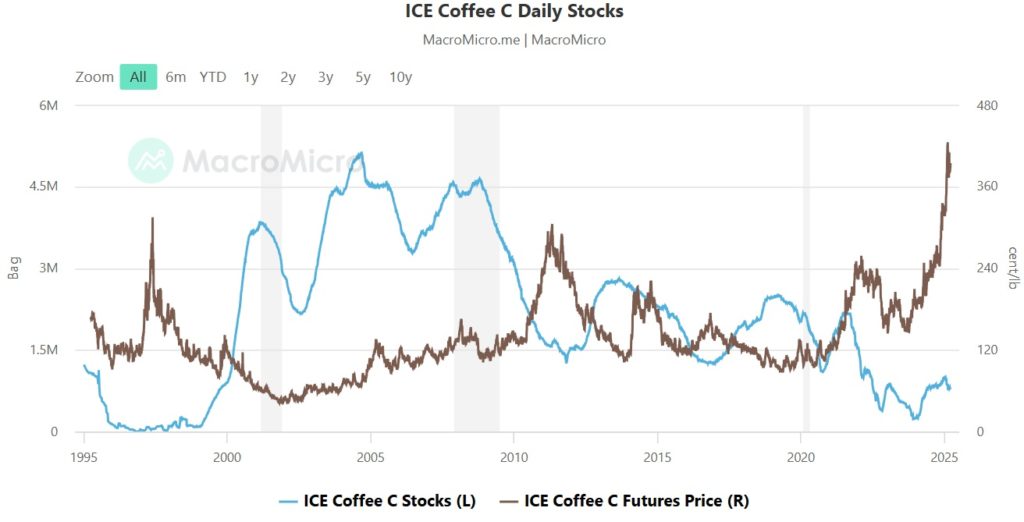
CERTIFIED COFFEE STOCKS: THE HIDDEN LEVER BEHIND GREEN COFFEE PRICES
While headlines focus on climate shocks or C Market volatility, one powerful yet often overlooked driver of green coffee prices is the level of certified coffee stocks—particularly those held at the Intercontinental Exchange (ICE) in New York (Arabica) and London (Robusta).
What Are Certified Coffee Stocks?
Certified stocks are ICE-approved lots of green coffee that meet strict quality, moisture, and grading standards. These coffees are:
Stored in licensed warehouses (e.g. New York, Miami, Hamburg, Antwerp, Barcelona)
– Eligible for physical delivery on coffee futures contracts
– Audited and traceable, representing a standardized reference quality
In a sense, they act as the « visible reserves » of the international coffee trade. The two key segments:
– Arabica (ICE Futures U.S. – New York)
– Robusta (ICE Futures Europe – London)
These stocks serve as a real-time barometer of supply availability for the exchange-traded market. A drop in these reserves typically signals:
– Tight supply
– Delays in arrivals or slower approvals
– Strong demand for exchange-quality coffee
This leads to a bullish pressure on futures prices.
Conversely, a surge in certified stocks can reflect weaker demand or oversupply, placing downward pressure on prices.
Recent Developments (Q1 2025)
As of January 30, 2025:
Arabica certified stocks fell by nearly 100,000 bags, to around 900,000 bags, the lowest levels seen since 1999.
Simultaneously, Arabica futures neared $4/lb, marking a multi-decade high.
London’s Robusta certified stocks remained tight, echoing similar supply-side strain.
This drop is partly attributed to logistical bottlenecks, drought in Brazil, and diversion of high-quality lots to specialty markets.
(Source: ICE Stock Report, Reuters Jan 30, 2025)
The Correlation: Certified Stock vs. Price
Let’s decode this relationship in analytical terms:
Directional Impacts:
↓ Certified Stocks ↑ Futures Price (C Market)
↑ Certified Stocks ↓ Futures Price
The correlation is inverse, yet non-linear — moderated by macroeconomic signals (e.g., USD strength), crop forecasts, and geopolitical risks.
Strategic Takeaways
For Traders and Importers:
– Watch ICE stock reports weekly — they are leading indicators of price movement.
– Strategize hedging and contracting timing based on stock dynamics.
For Roasters:
– Certified stocks offer price visibility and signal potential supply disruption risks.
– Evaluate whether to secure certified lots early in tightening cycles.
For Producers:
– Understand that lower certified stocks may support premiums — particularly if your coffee meets ICE specs or feeds into the specialty pipeline.
Final Thought
Certified coffee stocks are not just numbers on a warehouse ledger — they are real-world signals of trust, quality, and market readiness.
Tracking them is like checking the pulse of the global coffee bloodstream.
graph: Cafe Import